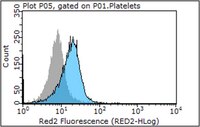Changes in the structure and function of the human thrombin receptor during receptor activation, internalization, and recycling.
Brass, L F, et al.
J. Biol. Chem., 269: 2943-52 (1994)
1993
Abstract anzeigen
According to current models, human thrombin receptors are activated when thrombin cleaves the receptor's N terminus, exposing the tethered ligand domain, SFLLRN. In the megakaryoblastic CHRF-288 cell line, thrombin receptor activation is followed by the rapid internalization of > 90% of the receptors. In the present studies, antibodies directed at the site of cleavage by thrombin were used to examine changes in receptor structure during activation, internalization, and recovery. As would be expected, the initial rate of receptor cleavage was directly related to the thrombin concentration. However, even after prolonged incubation, receptor cleavage was incomplete until the thrombin concentration exceeded the receptor concentration. Only cleaved receptors were internalized in response to thrombin and only catalytically active thrombin and active variants of SFLLRN-containing peptides caused receptor internalization. Over a 3-h period following receptor activation by thrombin, there was a gradual recovery of approximately one-quarter of the receptors on the cell surface. These receptors were detectable with antibodies directed at retained portions of the receptor N terminus, but not with antibodies directed at the proposed site of cleavage, confirming that they are recycled, rather than new, receptors. At 4 degrees C two-thirds of the receptors cleaved by thrombin were retained on the cell surface. Like recycled receptors these "cold-cleaved" receptors failed to self-activate when warmed to 37 degrees C, but could be activated by SFLLRN. Unlike recycled receptors, however, the cold-cleaved receptors were also internalized and appeared to be activated by a second addition of thrombin. These results 1) provide strong evidence at the protein level that thrombin cleaves its receptors at the predicted site, 2) show that receptor activation is necessary for internalization, 3) suggest that each thrombin molecule may not activate large numbers of receptors, 4) demonstrate that a substantial fraction of internalized thrombin receptors can be recycled, and 5) suggest that the failure of recycled receptors to be reactivated by thrombin may involve a change in the receptor that does not occur at 4 degrees C. Finally, the inability of cold-cleaved receptors to self activate in the absence of thrombin, suggests that in addition to cleaving the receptor, thrombin may also play an important role in guiding the tethered ligand domain to regions on the remainder of the receptor that mediate activation. | 7507931
 |
Internalization and recycling of activated thrombin receptors.
Hoxie, J A, et al.
J. Biol. Chem., 268: 13756-63 (1993)
1992
Abstract anzeigen
Shortly after activation by either thrombin or the tethered ligand domain peptide SFLLRN, thrombin receptors undergo homologous desensitization, temporarily losing their ability to respond to both agonists. We have examined the role of receptor internalization and recycling in this process using receptor-directed antibodies as probes. The results show within 1 min of activation > 85% of the approximately 200,000 thrombin receptors on megakaryoblastic human erythroleukemia (HEL) and CHRF-288 cells are sequestered into endosomes via coated pits, after which the majority are transferred to lysosomes. This process does not require proteolysis of the receptor and occurs with sufficient speed to play a major role in the regulation of thrombin receptor function. Although most of the internalized receptors are ultimately degraded, approximately 25% return to the cell surface. These recycled receptors are in a state in which they can respond to SFLLRN but not thrombin; nor do they self-activate despite the apparent continued presence of the tethered ligand. In contrast to other G protein-coupled receptors, which are internalized and then recycled in an activatable state, recovery of the thrombin response occurs only after the expression on the cell surface of adequate numbers of newly synthesized receptors. | 8390469
 |
Structure and function of the human platelet thrombin receptor. Studies using monoclonal antibodies directed against a defined domain within the receptor N terminus.
Brass, L F, et al.
J. Biol. Chem., 267: 13795-8 (1992)
1992
Abstract anzeigen
Based upon its recently cloned nucleotide sequence, the human platelet thrombin receptor is thought to be formed by a single polypeptide chain with seven transmembrane domains and an extracellular N terminus that can be cleaved by thrombin. As yet, however, little is known from studies of the receptor protein itself. To obtain such information, we have prepared monoclonal antibodies against a peptide corresponding to receptor residues Ser42 through Phe55, the domain immediately distal to the site of cleavage by thrombin. By flow cytometry, all of the antibodies reacted with the thrombin-responsive megakaryoblastic CHRF-288 and HEL cell lines, but not with the T-lymphoid Sup-T1 cell line. Functionally, the antibodies inhibited platelet responses to alpha-thrombin, gamma-thrombin, and trypsin, but had no effect on platelet activation by ADP, epinephrine, or the thromboxane analog U46619. Radioiodinated antibody bound to approximately 1,800 sites/platelet, a value similar to the reported number of moderate affinity thrombin binding sites per platelet. On Western blots, the antibodies recognized a 66-kDa protein in platelet, HEL, and CHRF-288 membranes. The discrepancy between this apparent size and the predicted mass of the receptor suggests that, as with other G protein-coupled receptors, one or more of the potential sites for N-linked glycosylation have been utilized. Therefore, these results suggest that: 1) the cloned thrombin receptor is involved in a broad range of platelet responses to thrombin, as well as gamma-thrombin and trypsin; 2) as predicted, the N terminus of the receptor is accessible on the platelet surface; 3) the moderate affinity thrombin binding site noted in earlier studies may be the receptor; 4) potentially as much as one third of the mass of the receptor is carbohydrate. | 1321125
 |











